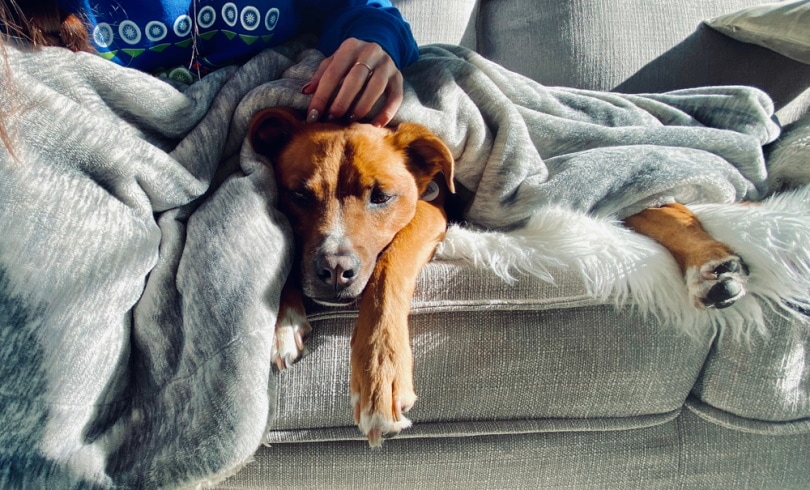One of the best things about dog ownership is curling up together in the living room at the end of a long day. While you turn on the TV or grab a book that you’ve been meaning to finish, your puppy cuddles up to you and snoozes the evening away.
As your dog dreams, you may find that they eventually start twitching. If your puppy is still new and you’re not familiar with dogs, you may find these movements concerning.
More often than not, though, these twitches and barking are harmless. If you’re familiar with REM sleep, you’ll know that this is the stage where we dream. You might be surprised to know that dogs dream during this stage too.
Admittedly, dogs don’t spend as much time dreaming as humans do, and it’s more common to find puppies and senior dogs twitching as they dream. Dogs of all ages chase their dream squirrels around their dream gardens occasionally!
What Do Dogs Dream About?

Since there’s no way of asking our dogs what they dream about, we can only speculate. A common belief is that they dream of chasing their favorite things. Whether it’s squirrels or rabbits or their favorite ball, it stands to reason that our dogs dream about these games all the time.
There is also the possibility that they dream about us. It’s entirely plausible that our beloved hound’s dreams are filled with belly scratches and treats from their favorite two-legged friends.
Let’s face it, though, they’re probably dreaming about squirrels.
Do Dogs Have Nightmares?
With dreaming comes the occasional nightmare. Unfortunately, this fact is true for dogs as well. At some point, you might find your puppy’s usual twitching and endearing barks replaced by whines, worried yelps, or screaming. It’s hard to say whether dogs have imaginations, but dreaming of memories, particularly the bad ones, is something that we all do.
If you adopted a dog from a shelter, you may find that they’re slightly more prone to recalling bad memories, especially if they have a history filled with abuse and neglect. Even with the amount of love that we shower upon our best friends, some things will never be forgotten.
Anxiety can also be a cause of nightmares. If your dog experiences a day filled with new smells and a broken routine, you may find them suffering from nightmares later. Dreams and nightmares help dogs process their experiences and there’s not much that you can do except offer more belly scratches when they wake up.

What’s the Difference Between a Seizure and a Dream?

While dreams are the biggest cause of twitches during your dog’s sleep, there is a possibility of another, more dire reason.
Seizures are uncontrollable muscle spasms originating in the brain due to various factors. Usually, seizures occur when dogs are awake, but it’s possible for them to happen while your dog sleeps.
Telling the difference is relatively easy. Dream twitches are relaxed. They’re loose, fleeting movements that usually occur in the legs, head, and tail, and they are accompanied by quiet vocalizations. After a few seconds, your dog will drift into quiet sleep again. Through it all, your dog will respond to voices and wake up when you call their name.
Seizures, in comparison, are quite different. They’re rigid, and for the observer, terrifying. Unlike dreams, your dog will be completely unresponsive. You may also find that they lose bladder and bowel control, foam at the mouth, and vomit. Afterward, your dog will be disoriented.
Not all seizures are the same, though. If you’re not sure, check with your vet.
What Causes Seizures in Dogs?
Like humans, dogs suffer from seizures for many of the same reasons, epilepsy and cancer being two of the biggest concerns. Taking your dog to a vet as soon as possible will help diagnose the issue.
The 4 Things to Do When Your Dog Has a Seizure

Tending to seizures, for animals or humans, works on the same principle.
1. Stay Calm
The first and one of the most important responses is that you have to stay calm. It’s difficult, but a steady, reassuring presence will help your dog far more than restless pacing and tears. They’ll wake up confused and disoriented. A few words of reassurance will help them calm down.
2. Check for Danger
If your dog is experiencing a seizure, don’t try to move them. Instead, move anything around them that may be knocked into and cause issues. If they’re curled up on the bed or couch, stay nearby and make sure they don’t topple off.
Don’t try to hold your dog still; this will only heighten the possibility of injuries. Also, don’t put your fingers in their mouth to try to stop them from choking on their tongue. Your dog will have no control over their movements, and biting your fingers may result in you losing them.
3. Check the Clock
Timing the seizure isn’t the first thing that you’ll think of, but keeping a close eye on the clock will help your vet diagnose the severity of the seizure. If your dog hasn’t had a seizure before, mentioning it to your vet is important because it could be a sign of a developing health issue.
Any seizure should be reported to your vet.
4. Pay Attention
After the seizure is over, keep a close eye on your dog. If they have more than one seizure within 24 hours, tell your vet.
Let Sleeping Dogs Lie

If your dog is dreaming and you’re worried about particularly vigorous twitches, it can be tempting to wake your dog up with a scratch behind the ears. This isn’t recommended.
If your dog is in the middle of a speedy chase, a sudden touch may startle them. They could inadvertently bite or scratch you. It’s safer to let your dog dream.
There may be a reason that waking your dog is necessary. Whether you want to check for a suspected seizure (remember, your dog won’t respond in this case) or can’t stand to see them suffering from a nightmare, there’s one way to wake your dog up.
Instead of shaking your dog awake, call their name or make a loud noise. This will serve to keep both you and your dog safe, along with bringing them out of their bad dreams. You can soothe their frayed nerves afterward with a few pets.

Conclusion
More often than not, your dog twitching in their sleep is benign, and you can amuse yourself wondering what critter your pooch is chasing.
Sometimes, though, involuntary twitches can be more serious. Seizures can be caused by several health issues and requires a trip to the vet. Recognizing the difference between a seizure and harmless dreaming will help you keep your dog healthy and safe.
See Also:
- Why Is My Dog Pacing? 11 Potential Reasons and How to Stop It
- 8 Best Dog Foods for Seizures – Reviews & Top Picks
Featured Image Credit: Benevolente82, Shutterstock











